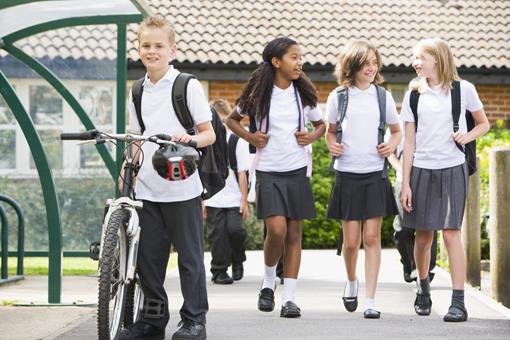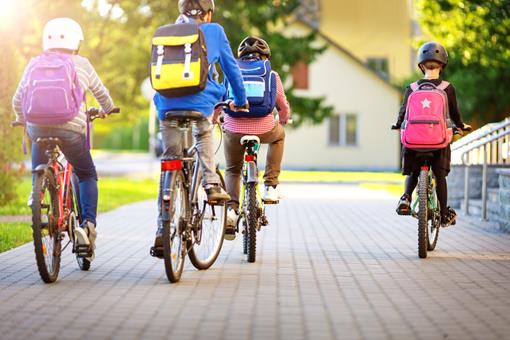Encouraging walking and biking to school

Encouraging walking and biking to school
With national walk and bike to school day approaching on the 5th of October, SBMs must start to think about encouraging staff and students to walk or bike to school. There are many ways SBMs can implement walking and biking to school, but the main aim is to plan strategies for a pedestrian safe journey.
Encouraging walking and biking to school can be difficult but we have provided some useful ways in which SBMs can get staff and students walking and biking. These can be implemented ready for national walk and bike to school day and can be built upon for the long-term.
Benefits of walking and biking to school
Walking and biking to school come with many benefits so it is important to instil it into students and staff, and even yourself. Not only is it the ideal opportunity to get students and staff involved in more activity and integrate walking and biking into their everyday lives, but it improves people’s health. Plus, it reflects positively on the school as it shows that physical activity is a valued priority for the school.
Walking and biking to school also helps to reduce congestion traffic which has a positive impact on the environment. This is due to less cars being on the roads at peak times as more people are choosing physical activity to commute.
How to encourage students and staff to walk or bike to school
Walking school bus
A safe way for your students to walk to school is by organising a local walking school bus in the surrounding areas. To start a walking school bus, gather willing teachers and parents to walk with children and plan out the routes to school. During this planning process, find meeting points for people to join the walking bus as well as the first meeting point. Schedule a timetable for the walking bus and offer this information to parents and staff.
To ensure adults are on board with this, create meetings with parents and staff to discuss how to implement a walking bus. Plus, they can ask questions about any hesitations they may have and SBMs can provide them with solutions.
Biking train
Similar to a walking bus, SBMs can provide a biking train for children to bike to school safely. Invite students and staff to bike to school together in groups. Again, like the walking bus, plan out routes and keep staff and parents informed about schedules and safety.
Hold meetings with staff and plan the bike train thoroughly with them. Create a cycling safety guide to give to staff and include it in letters to parents so any concerns about safety will be addressed. This will encourage parents to allow their children to bike to school. Ensure the planned routes are safe and not busy with vehicles. Also, for every bike train group, ensure there’s one adult for every three to six children.
Supply helmets in school for people to use as a way of encouraging biking to school.
Park & walk
For people who live too far to commit to walking and biking to school, create a park & walk system so that they can walk or bike the rest of the way. Find a place for parking where everyone can start to walk or bike together that is around a mile or half a mile away from the school.
Gather willing members of staff who also live too far away to meet parents and children at the car park. Or this could even be yourself. This ensures that there is guidance and representation from the school which gives extra safety.
Storage for bikes
Create a space in your school for bike storage and parking to encourage students and staff to commute to school via bike. This should be a priority so that students and staff feel comfortable with taking their bikes onto school premises. Ensure that the space is large enough to fit bike rails and offer individual locks so that bikes are safe and secure.
Bike safety sessions
Plan bike safety sessions for your school to ensure that students are aware of the rules of the road. Doing this will give children the knowledge on how to stay safe whilst biking to school. Students will start to feel more comfortable with the idea of biking to school after thorough safety sessions.
If parents or guardians are unable to go with students, organise staff volunteers to meet them and cycle with them. This is crucial for younger children to keep them safe en-route to school.
Pedestrian safety sessions
Pedestrian safety sessions are just as important as bike safety sessions. With increasing congestion children need to understand how to stay safe whilst walking to school. Thoroughly plan pedestrian safety sessions where students will gain the correct knowledge. It is particularly crucial for the older students who walk alone to school, so make sure to plan in extra sessions with them.
In these sessions, use traffic signs to explain what they mean so students can understand the rules of the road better.

Enlist the help of parents
Send letters to parents to show them the benefits of walking and biking to school. Set out the planned recommended routes that you have organised. Parents who can’t join the walking bus or riding train will then know the best routes to take with their children. Also, include information on activities taking place for the school. Give parents the option of joining in and show them how they can get involved to encourage them to be on board.
Prioritise walkers and bikers
Allow priority to walkers and bikers as a great way to get staff and students walking and biking to school. Create separate entrances and exits for pedestrians and cyclists if this is possible for your school. If it’s not possible, find a way to hold back traffic at a pick-up and drop-off point until pedestrians are all in or out of the school premises. You can do this by marking off sections with cones or signs. This will ensure that crossing roads near the school is easier and safer for those who have chosen to walk or cycle.
Walk or cycle to school day/ week
Organise a special walk to school day or week which can encourage people to do this regularly. To get students interested in participating, turn it into a school competition of who can walk or cycle to school the most in that week. If you opt to do just a day, hand out rewards to students who participated. This can be as simple as congratulations postcards.
Hold this special event every year to remind students and encourage new students to start walking or cycling to school more often.
Change drop off points for school bus
Instead of having the school bus drop students off right outside of the school, change the stop to a mile away so that students can walk together the rest of the way. Have staff volunteers waiting outside the new bus stop to walk with them for safety. This is ideal for children that need to get the bus to school every day so that they can participate and start walking more.
Establish a walk to school policy
Have a walk to school policy within the school’s travel plan. Make sure that this policy aims to promote walking and biking to school as well as how this will be achieved, safety concerns and how to combat them, and how the policy will be measured. This will strive you to continue encouraging everyone to walk and bike to school and assist in putting a long-term plan in place.
Invest in a lollipop person
Safety for pedestrians is vital for SBMs to prioritise and plan out. If your school is situated near a busy road, ease the pressure of safe crossing by investing in a lollipop person. These people can be there at peak times starting in enough time before the school day begins and ends. Plan out the best times for the lollipop person to start and finish and when they shall return. Consider how busy the road gets before school begins and how many students arrive early on foot. Remember that when school starts it is also rush hour traffic for work.
Activities to assist
Suggest some activity ideas that staff can implement into their lessons to encourage students to walk or bike to school. Here are some ideas to share with your staff to get as many students involved as possible:
- Create walking to school posters for the national walking and biking to school day
- Create signs for national walk and bike to school day
- Play a game of charades guessing what it is and if its inactive or active
- Write a short story about the journey to school and illustrate it
- Do some exercises and count breathing rates and pulse
- Discuss why being physically active is important
- Give out walk to school diaries so students can log how they got to school each week for the long-term
Implement this advice into your school to start gaining interest in walking and biking to school. Ensure you set out plans for this to be long-term and advocate for walking and biking. Reduce local congestion and find alternative ways to keep this system in place. Walking and biking to school is often overlooked due to the rise of cars and little accessibility for pedestrians and cyclists. Be different from other schools and provide that accessibility and put walking and biking first.
For inspiration in getting more active and encouraging yourself to walk more read our top places in the UK to go walking blog.

